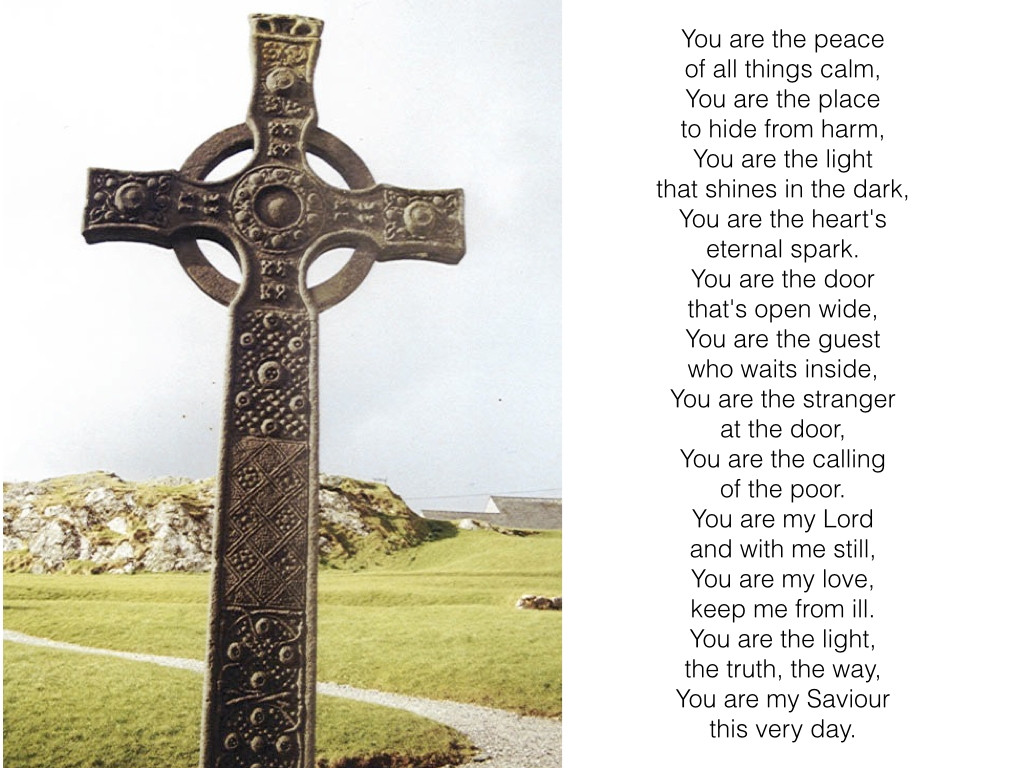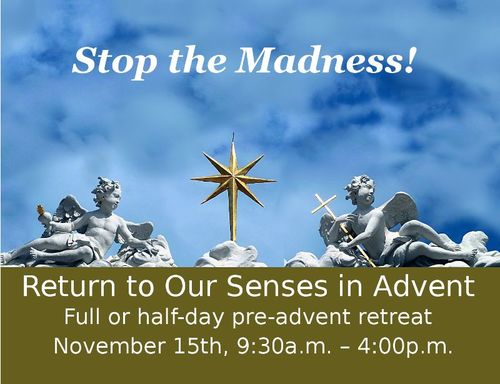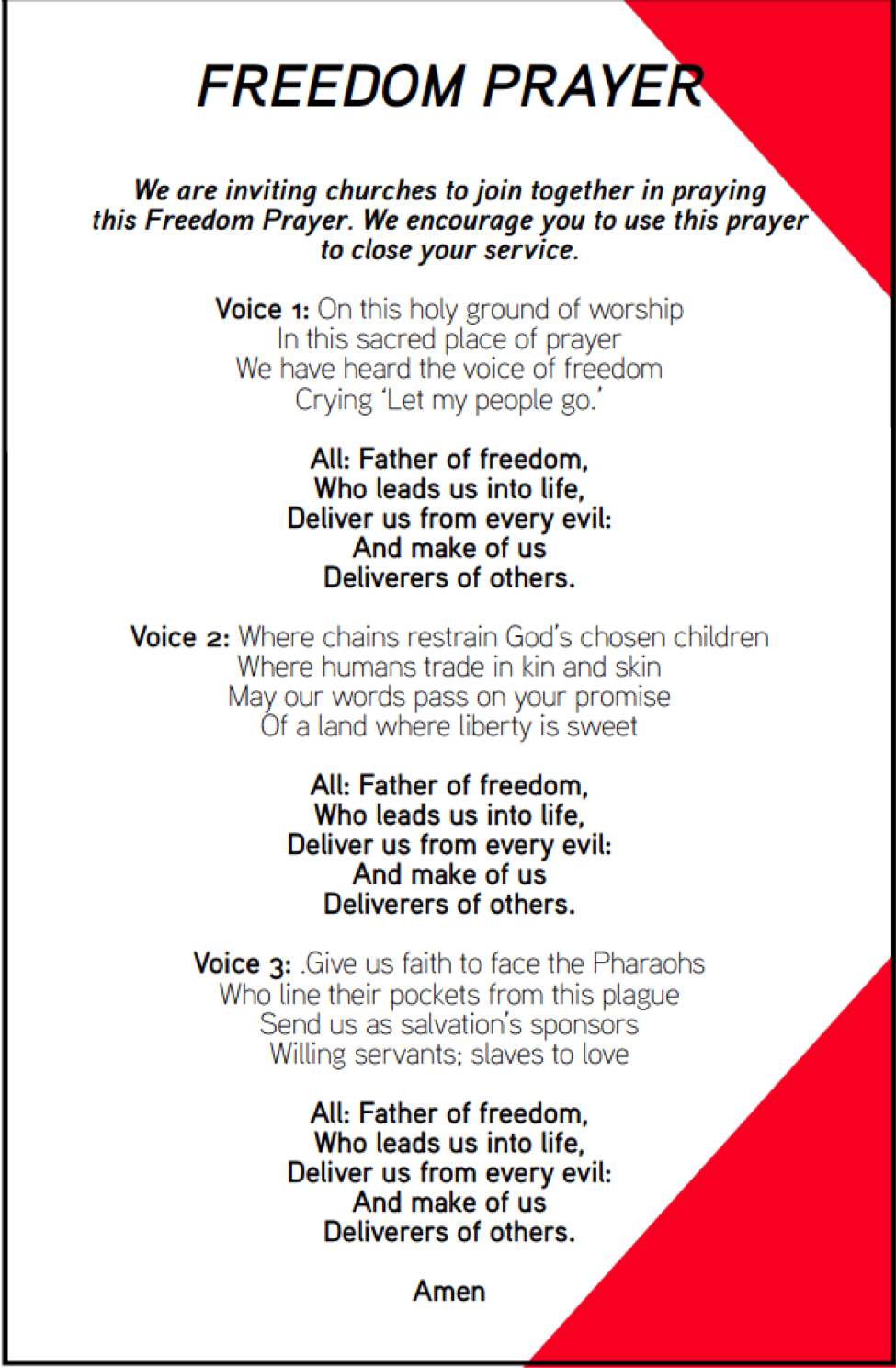The season of Advent, the beginning of a new liturgical year starts November 30th and it is time to get ready. How serious will you be about this journey toward the manger and the birth of Christ?
In The Liturgical Year, Joan Chittister, says:
The function of Advent is to remind us what we’re waiting for as we go through life too busy with things that do not matter to remember the things that do. Advent asks the question, what is it for which you are spending your life?”
We all desperately crave more meaningful, less cluttered, lives, yet we rarely take the time to slow down and ask this question. We invite you to prepare for Advent and Christmas this year by refocusing your life on what really matters. Take time to renew, refresh and restore your priorities.
Join us November 15th at the Mustard Seed House for a contemplative retreat I will facilitate , based on my book, Return to Our Senses: Reimaining How We Pray.
Last year participants told me the retreat was not long enough so we have made full and half day options possible.
Join us for the full day and experience a morning of reflection, contemplation and inspiration that will encourage you to journey toward Christ’s birth with renewed focus and faith. Learn from the rich presentations and reflective insights of fellow participants how to deepen your prayer life and draw closer to God.
In the afternoon exercise the insights and skills you have learned to develop your own spiritual practices for the seasons of Advent and Christmas and create your own special sacred space as a focus for celebrating the season.
When: November 15th
Full-Day: 9:30a.m. – 4:00p.m.
Half-Day: 9:30a.m. – 1:00p.m.
Where: The Mustard Seed House, 510 NE 81st St, Seattle WA 98115
Cost: Full-Day: $50
Half-Day: $30
(both 1/2-day and full-day options include lunch)
Include a copy of Return to Our Senses or our new devotional resource: A Journey Toward Home, for only $10 more!
Space is limited to fifteen participants so please sign up soon. We would appreciate you helping us promote this event by downloading and sharing our flier, as well as sharing on Facebook, and twitter.
God in heaven holds each person by a string. When you sin, you cut the string. Then God ties it up again, making a knot – and thereby bringing you a little closer to him. Again and again your sins cut the string – and with each knot God keeps drawing you closer and closer.
These words, written by Meister Eckhart, a thirteenth-fourteenth century philosopher, theologian, and mystic, form the basis for our meditation this week. His imagery has stirred my imagination and I hope it will yours too.
Find a piece of string or rope or yarn and hold one end in your hand. Like me you might like to use two pieces for comparisonStretch it out across your sacred space. Close your eyes and imagine that God is holding the other end. Alternatively tie this end to an image that reminds you of God. Sit quietly for a few moments sensing the security and love that flows between you and God along that string.

Now remind yourself of something you have done in the last few weeks that has made you feel as though the “string” that connects you to God has been cut. Cut the string that you hold in your hand and sit looking at it for a few moments. Imagine that before you cut the cord it was frayed. In this case you would not just need to cut the cord but to remove the entire frayed and weakened section before creating your knot.
What is your response: How does it feel to be disconnect from God? Are there areas in your life where you feel your connection to God is frayed? Are there things that need to be removed before the knot is tied? Is there a need for repentance? Is there something else you need to do to experience God’s forgiveness?
Now tie a knot in your string. Imagine yourself, forgiven and once more connected to God. Notice that the string is now shorter than it first was, and the more complex and beautiful the knot you tie is, the shorter the string becomes. Sit and hold it in your hands. Cut or break the cord in several places and tie knots. The cord has become even shorter. Sit and contemplate it for a few minutes.
What is your response: Where has God “tied the knot” for you in the last week? In what ways do you feel closer to God as a result. Sit and appreciate your closeness to God and offer prayers of gratitude. Think about the new and beautiful patterns that have been created in your life as a result.
Knotted strings can be crafted into patterns that are often not just strong but beautiful – braids, or knotted cords, jewelry and prayer beads. Think of objects you have around your home that are made from knotted cords. If there is something special that you think of take it out and contemplate it for a while. I pulled out my collection of braided bookmarks, collected around the world. They are reminders of friends I have known and people whose pain I have shared.
Notice too that often patterns like these are created by knotting or braiding many cords together. Ecclesiastes 4:12 tells us a cord of three strands is not easily broken. Where in your life are you aware of the strengthening that others have brought to your connection with God without the need for cutting.
What is your response: Write down what you sense God is saying to you as you meditate on your string and knotted objects.
Watch the video below and think about how the knots that God has tied have become strong and beautiful patterns in your life. Now, if you have time, take another piece of string or rope and make the Celtic love knot below. Imagine this is the love of God holding your life together. Sit secure in that love and enjoy the presence of God.
Suggested music. I love this John Michael Talbot song and it makes an excellent meditative background for this exercise. It is part of a collection of meditative music so you can continue listening to your heart’s content and for as long as you have time to set aside for the meditation.
It is rare for me to do two posts on a single day but I was so moved by this prayer and the wonderful resources available from the Church of England on human trafficking and slavery that I just had to add this. The prayer comes from this excellent resource
Freedom for Worship and Action which can be downloaded as a pdf. You may not be celebrating this weekend but whenever you decid
October 15th was the feast day of Teresa of Avila. And I missed it, partly because I was so occupied with the concerns of this world, the pull of World Food Day and the aching desire to pray for those impacted by ebola. But I did not want to let the week go by without highlighting this amazing woman, so I thought that just as I started the week’s posts with a meditation so I would end it.
I have always found inspiration from the lives of those who have gone before us. Their footprints provide places for me to stand and words and prayers encourage and strengthen me as I too seek to move forward into the ways of God.
Teresa of Avila is one such person. In many ways she was a very ordinary person – struggling with some of the same life challenges we struggle with today. But out of that struggle came a rich inner prayer life that continues to inspire many today. Like the prayer abovewhich I posted on Light for the Journey on October 15th.
One of my favourites however is the following prayer which speaks to me as I contemplate how I can respond the many challenges our communities and our world face.
Read it through several times. Listen to the beautiful musical rendition at the end of the post. Allow their truths to take root in your heart. I prayed this prayer several times this morning as I considered the plight of of those infected or quarantined because of Ebola. As you read this prayer and listen to the music may you too consider what action God may ask of you as a result of reading and meditating on them
“Christ has no body now, but yours.
No hands, no feet on earth, but yours.
Yours are the eyes through which
Christ looks compassion into the world.
Yours are the feet
with which Christ walks to do good.
Yours are the hands
with which Christ blesses the world.”
Music by David Ogden
Over the last couple of months I have posted a number of guest posts, resource lists and my own thoughts on spiritual direction. I have found a number of exciting books to read in the process and have certainly had my own thoughts stirred by what has been contributed. This has also led to my new practice – Meditation Monday.
Here is a list of the posts so far, and if you too have been encouraged to develop new practices or read new books as a result, we would love to hear from you. And if you want to contribute, there is still time to do so. I will accept posts until the end of October.
My favorite book on spiritual direction by Lynne Baab
Travelling whilst staying still … a feather on the breath of God by Kate Kennington Steer
Spiritual Midwives by Kathy Escobar
Pinheads, Dancing with God and Why I Hate Discernment by Robert Rife.
Leadership As Spiritual Direction
Hearing God’s Voice Communally by Lynne Baab
What Is Spiritual Direction? Insights from Margaret Guenther
Spiritual Direction – A Resource Guide
Meditation Mondays
Meditation Monday – The Sounds of Silence
Meditation Monday – Beauty in Every Season
Monday Meditation – In Day’s First Light
Monday Meditation – I Will Rest in the Circle of God’s Love
Prayer and Meditation for the Day
 Advent and Christmas are coming. Many of us have already turned our thoughts to how we will celebrate the season. Once again I will host a series for Advent and Christmas on this blog, this year with the title: Come to the Manger Who Will You Invite?
Advent and Christmas are coming. Many of us have already turned our thoughts to how we will celebrate the season. Once again I will host a series for Advent and Christmas on this blog, this year with the title: Come to the Manger Who Will You Invite?
What on earth am I planning some of you may ask? I started Advent last year with a post: Stable, Inn or Welcoming Home – Where Was Jesus Born and Why Does it Matter which suggested that Jesus’ family was not abandoned in a stable but was surrounded by friends and family at his birth. To this birth celebration the shepherds, outcasts from their society, and the wise men, Gentile foreigners were also invited.
The question that stirs in my mind is: Who is welcome at the manger? Who else do we invite to this celebration that may otherwise be ignored or excluded – the prostitutes, the sex traffickers, those in prison, people of other racial backgrounds, other religions, other sexual persuasions, the poor and the homeless, even those we are estranged from. Do we think there is a place for everyone at the manger? If so how do we extend that invitation so that these people feel welcome?
Next week our new devotional A Journey Toward Home: Soul Travel for Advent To Lent will be available for order. One of the reflections in it is on the French custom of santons:
Santons are, literally, “little saints.” Part of a typical French Nöel crèche (Christmas Nativity scene), santons come in work clothes to visit the Holy Family. They bring the Christ Child presents they have made or grown, hunted or sold. They perform or offer simple gestures of thoughtfulness…..
The shepherds summon all Provençal villagers. They bring their unique gifts to honor the newborn child: the baker (or his son) with typical Provençal breads like la banette and le pain Calendal (a round country loaf marked with a cross and baked only at Christmastime), the vegetable merchant, the cheese vendor, the basket maker, the wine grower, the humble woman or man who brings only a bundle of sticks for a fire to keep the baby warm.
A poor old man, who thinks he has nothing to give the Baby, holds his lantern and offers to light the way for others. His gift of thoughtfulness and courtesy earns him a place in the scene.
I love this idea of all our neighbours, those we enjoy and those we don’t want to have anything to do with, clustered around the manger, invited into that place of intimate hospitality with God. So lets create our own “santons” this Advent and Christmas season, santons of words not figures of clay. Lets talk about some of the people we imagine gathering around the manger with us. Lets help others to see the embracing love of God for all of humankind in the birth of the child Jesus.
This is your invitation to participate in the Advent/Christmas series on Godspace. Would you like to contribute a blog post? Write a poem or even paint a picture of what the gathering around the manger could look like? If so please leave a comment on this post, or email me. And please invite your friends.
As an Amazon Associate, I receive a small amount for purchases made through appropriate links.
Thank you for supporting Godspace in this way.
When referencing or quoting Godspace Light, please be sure to include the Author (Christine Sine unless otherwise noted), the Title of the article or resource, the Source link where appropriate, and ©Godspacelight.com. Thank you!











